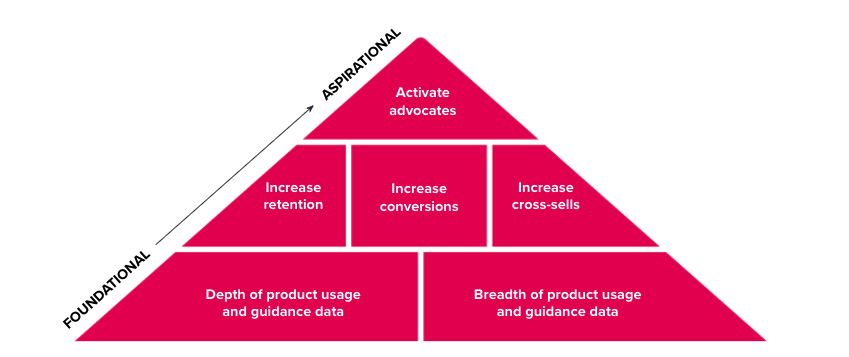Remember Maslow’s Hierarchy of Needs from grade school? Physiological needs, safety, belonging, all the way up to self-actualization? Well, there’s a version of that for building successful product-led organizations, too.
Being product-led means putting your product at the center of everything you do, and it necessitates focusing every part of your organization on the product. It’s a powerful approach that some of the world’s most successful companies have adopted. But, like Maslow’s famous pyramid, each piece of a truly successful product-led strategy relies on having the one before it in place to offer a strong foundation.
The Product-Led Hierarchy of Needs looks like this:

In short, you need to understand your product usage at the deepest level before you can start using product-led strategies to drive positive business outcomes and, ultimately, identify your product’s biggest advocates and activate them.
If scaling that slope seems daunting to you, don’t sweat just yet: Pendo’s powerful platform can support your team every step of the way. Think of us as an escalator for becoming product-led. Here are a few ways to leverage Pendo to drive a series of specific positive business outcomes.
Gauging product usage and adoption
From the moment it’s installed, Pendo collects every interaction with your web and mobile apps down to the visitor level, and all that data is available to you retroactively. That means Pendo is watching as usage of your application rises or falls, and you’ll be able to visualize and explore how your product is being used and what is driving those trends at any time without having to put any effort into tagging pages or features ahead of time.
You can also use Pendo’s segmentation capabilities to explore the data for different types of users in different roles.
Driving product engagement
Once all that data starts flowing in, Pendo offers a quick and easy way to understand the health of your product at a glance: the Product Engagement Score.
The Product Engagement Score is a number that measures product adoption, returning user stickiness, and new user growth to give you insight into the direction your product’s overall health is trending. Once you have a sense of that, you can start developing strategies to improve certain areas.
Say you notice product adoption is low on your internal, employee-facing app, for instance. To improve that metric, you can use Pendo’s analytics to identify the most-used features that you know user find the most value from (typically, about 10% of your features account for nearly 80% of your total usage) and then use Pendo’s Core Events feature to set goals for driving users toward functionality.
To drive adoption, you can leverage Pendo’s in-app guides and messaging capabilities to build multi-step onboarding flows to reduce time to first use of key features, or embed tooltips inside the application to keep users on the optimal path to success. These same tactics work well for cross-sell/upsell campaigns, too.
But what if time to first use for your Core Events is short, but no one returns to your app to use those features again? Then, you have a stickiness problem. Time to build better in-app guidance and onboarding processes and track their impact by keeping an eye on your daily, weekly, or monthly average users.
Maybe they’re just not completing a particular step in their workflow, and dropping out of the path you intended them to follow. Using Pendo, you can identify the friction point and remove it, or use a tooltip guide to help them figure it out, and they’ll be off to the races using the rest of your features.
Or, if you’re an early-stage product, driving growth might be a lot more important. So, you’ll keep a closer eye on that piece of the PES and develop strategies for improving it.
Measuring user sentiment
Tracking how usage of feature trends is just one way to measure its success. Another is to go straight to your users and ask them directly: Are you finding this feature valuable? Is there anything we can do that would make it even more useful?
Pendo’s in-app messaging features allow you to conduct these surveys right inside your app, when your users are actively using the feature. That way, any feedback they have to offer, positive or negative, is top of mind and you’ll get more relevant, detailed, and contextual answers. Then, you can combine the qualitative feedback with your quantitative usage data to see which areas are used most by detractors and which are used most by promoters.
You can also leverage Pendo’s Feedback product to build better roadmaps and prioritize high-value feature builds.

